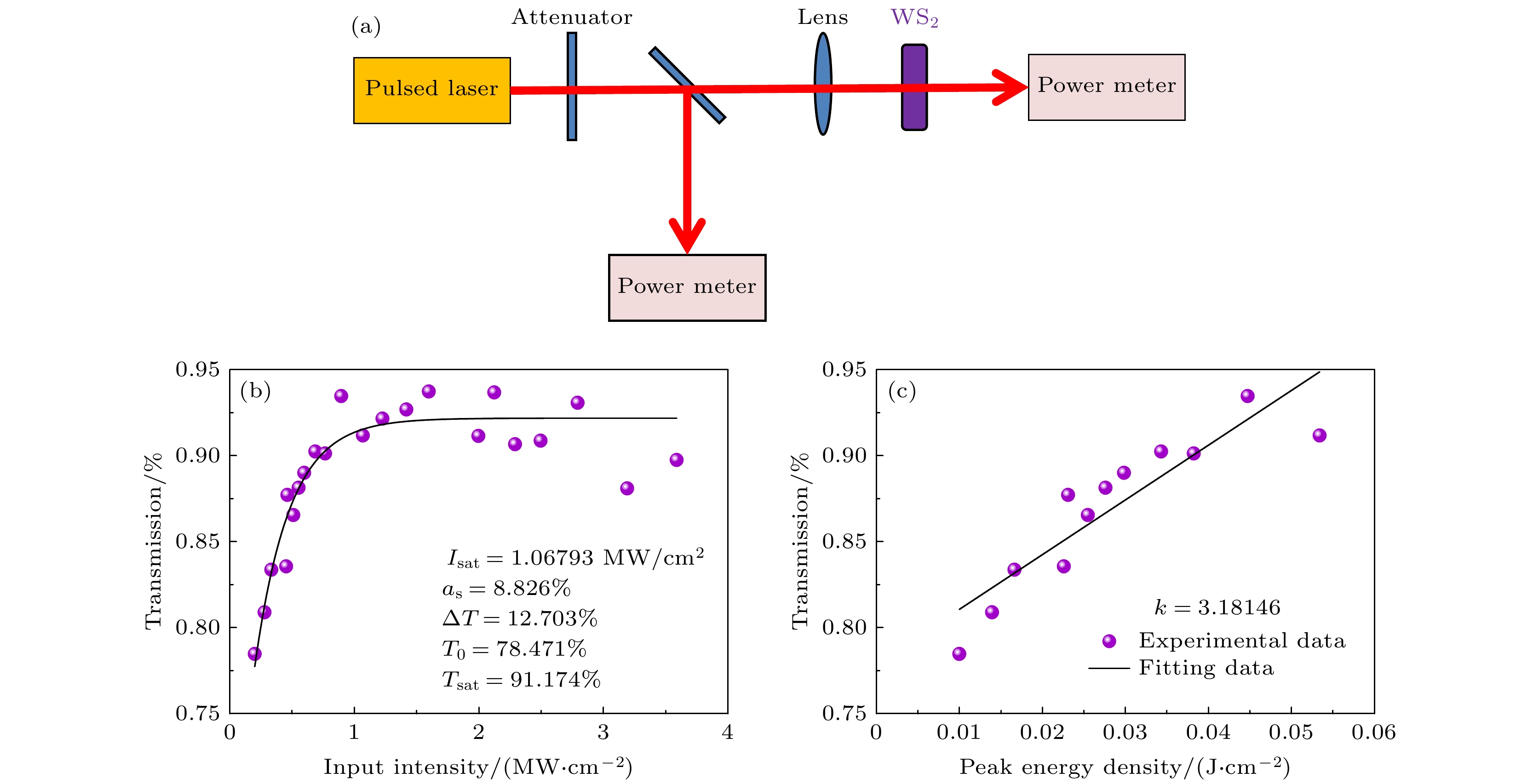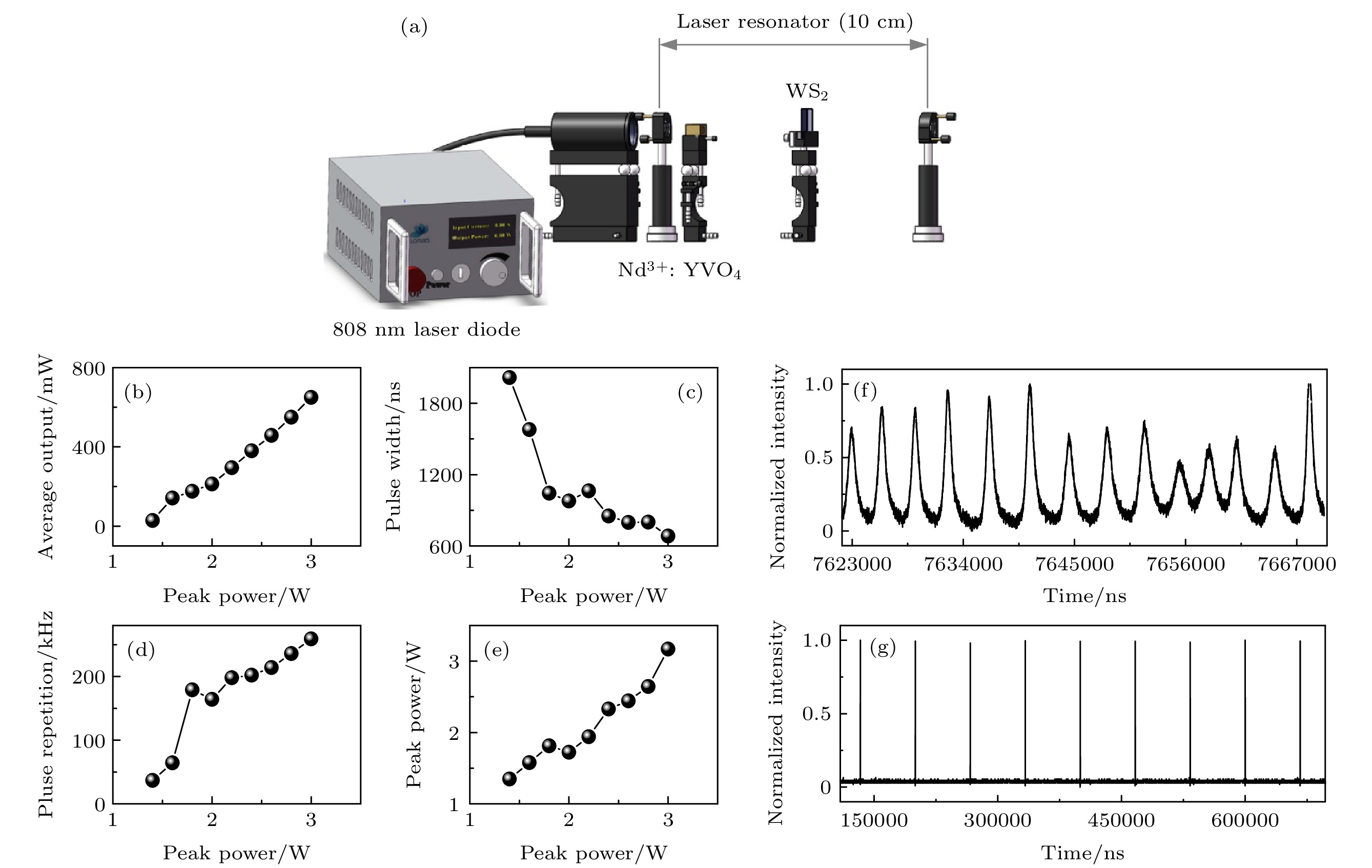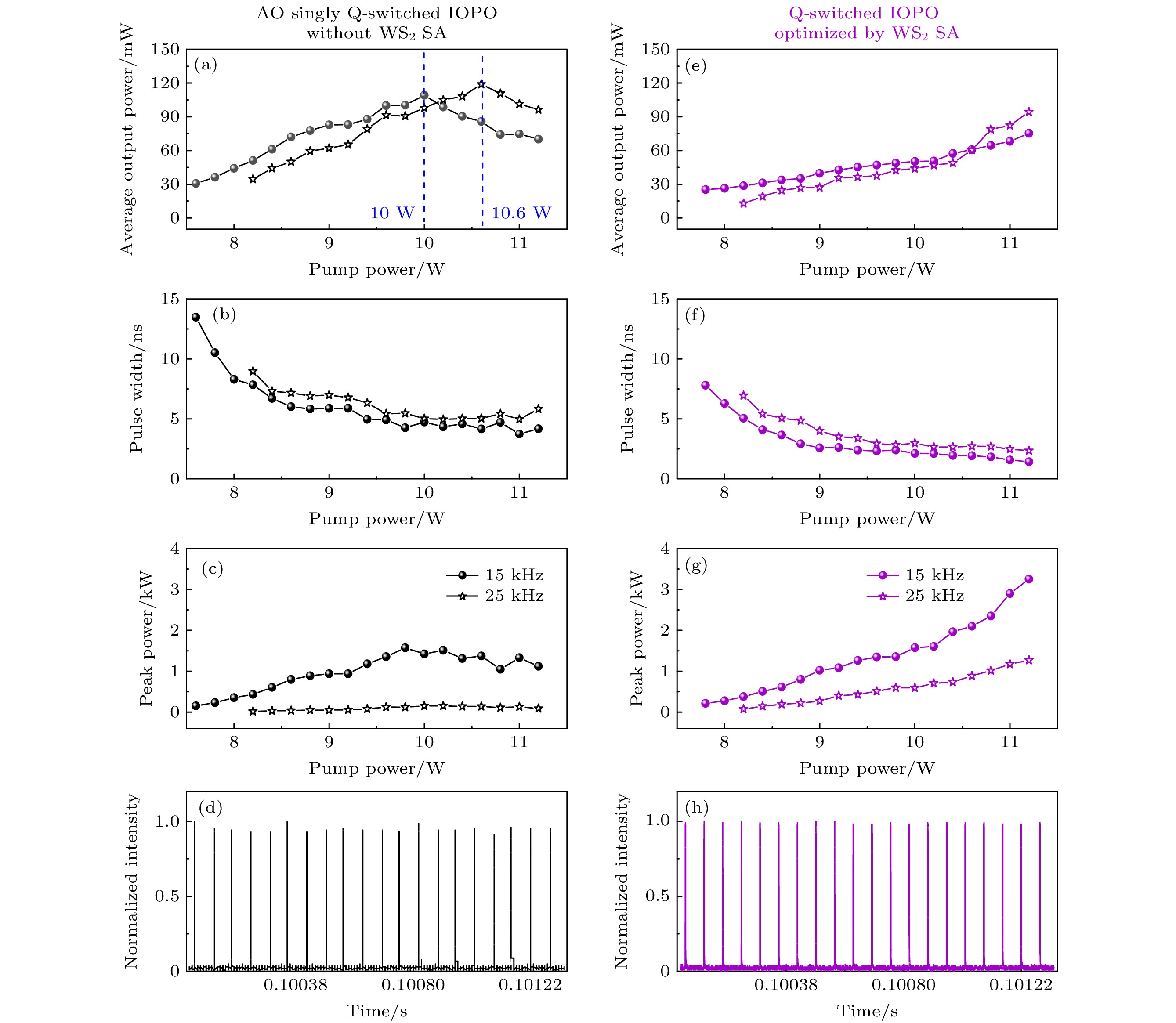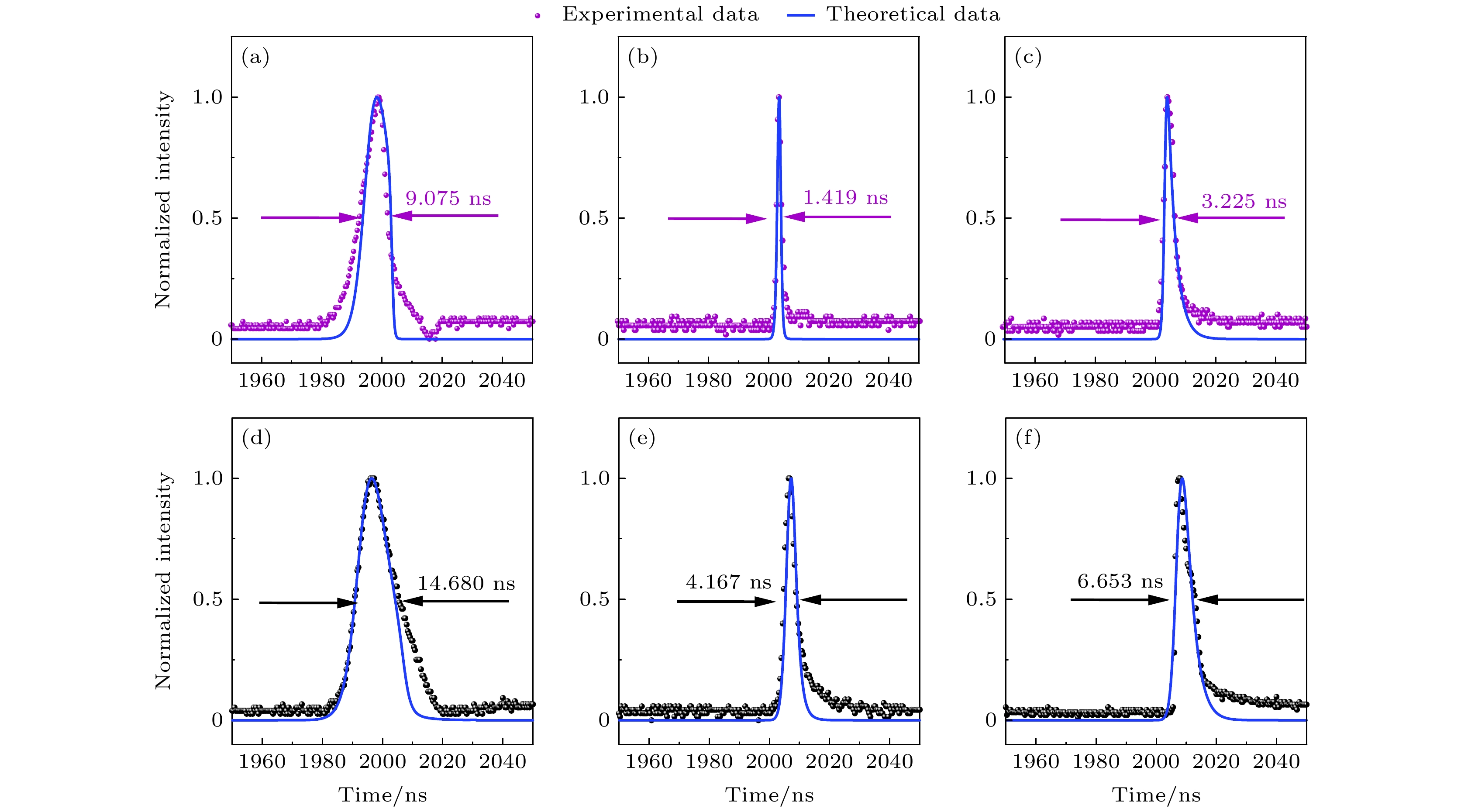-
光学参量振荡器是重要的中红外相干光源. 近年来, 在激光调制方面, 二维过渡金属硫化物展现了非线性可饱和吸收特性, 因此有望成为光学参量振荡器基频激光的优良调制元件. 本工作中, 首先, 实验测量了层状二硫化钨(WS2)调制固体激光的输出特性. 其次, 结合主动声光Q开关, 实现了主被动双调Q 光参量振荡的运转, 得到了纳秒脉冲宽度的中红外脉冲, 并研究了WS2对光参量转换的优化特性, 发现WS2纳米片除了能够压缩脉冲、提高峰值功率外, 还能缓解单主动调Q 光学参量振荡器中的“输出饱和下降”现象, 这种现象可能起因于砷酸钛氧钾 (KTiOAsO4, KTA)的制冷不均匀. WS2的可饱和吸收效应能够显著压缩光斑, 减少高斯光斑的边缘能量, 因此能够缓解KTA的温度梯度分布, 从而优化输出特性. 最后, 基于WS2的非线性透过率曲线, 考虑非均匀展宽机制和大信号下的非饱和吸收, 计算了WS2的可饱和吸收特性参数, 并求解了层状WS2调制光学参量振荡器的速率方程组. 本文在实验上展示了二维过渡金属硫化物对激光非线性频率变换的优化效果, 尤其是对热效应的缓解; 同时, 为二维材料调制激光的动力学模拟提供了参数依据.
-
关键词:
- 层状过渡金属硫化物 /
- 中红外光学参量振荡器 /
- 动力学方程 /
- 可饱和吸收截面
Optical parametric oscillator (OPO) is an important mid-infrared coherent light source. Two-dimensional (2D) transition metal dichalcogenide (TMDC) with nonlinear absorption of near-infrared-wavelength light is expected to be a prospective modulating switch for OPO’s fundamental laser. In this work, firstly, the characteristics of a home-made 3.5nm-thick tungsten disulfide (WS2) sample are measured and analyzed. The nonlinear transmission is figured and fitted, revealing the performance of WS2’s saturable absorption. Then, the output characteristics of WS2 saturable absorber (SA) modulated solid-state laser are measured experimentally. Although the photon energy of 1.06 μm-wavelength laser is less than the bandgap energy of 3.5nm WS2, the sample still exhibits the saturable absorption. This may be attributed to the mechanisms of defect-induced absorption, coexistence of states, edge-state of material, two-photon absorption, etc. Secondly, combined with active acousto-optic (AO) modulator, the active and passive Q-switched OPO with idler-light oscillation are implemented, and the nanometer pulse-width mid-infrared pulse is obtained. The implementation of AO modulator is to manage the regular switching time to reduce the pulse peak-to-peak vibration of fundamental light and improve the peak power. The optimal characteristics of WS2 for OPO are studied. Based on the saturable absorption characteristics, the output pulse is compressed by 60%, the peak power is improved by 191%, and the stability of pulse train is improved by 79.62%. Especially, the insertion of WS2 nanosheet could alleviate the “output saturation and drop” phenomenon in singly active-Q-switched OPO. This phenomenon may origin from the uneven refrigeration of KTA. Because the saturable absorption effect of WS2 can significantly reduce the transverse area of Gaussian beam, it can alleviate the temperature gradient distribution of KTA and optimize the output characteristics. Finally, based on the nonlinear transmittance curve measured for WS2, the absorption cross section of ground state and excited state are calculated to be1.732 × 10–17 cm2 and 4.758 × 10–19 cm2, respectively, and the lifetime of excited-state energy level and the initial population density of ground state are evaluated to be 400.6 μs and 1.741 × 1022 cm–3, respectively, by considering the inhomogeneous-broadening mechanism and unsaturated absorption under large signal. The rate equations of layered-WS2 modulated optical parametric oscillator are solved. This study shows the optimization effect of 2D TMDC on nonlinear conversion of laser, especially the mitigation of thermal effect. At the same time, it provides a parameter basis for the dynamic simulation of two-dimensional material modulated laser.-
Keywords:
- layered transition metal dichalcogenide /
- mid-infrared optical parametric oscillator /
- dynamical equation /
- saturable absorption cross section
[1] Loparo Z E, Ninnemann E, Ru Q, Vodopyanov K L, Vasu S S 2020 Opt. Lett. 45 491
 Google Scholar
Google Scholar
[2] 郝倩倩, 宗梦雨, 张振, 黄浩, 张峰, 刘杰, 刘丹华, 苏良碧, 张晗 2020 69 184205
 Google Scholar
Google Scholar
Hao Q Q, Zong M Y, Zhang Z, Huang H, Zhang F, Liu J, Liu D H, Su L B, Zhang H 2020 Acta Phys. Sin. 69 184205
 Google Scholar
Google Scholar
[3] Ashik A S, O’Donnell C F, Kumar S C, Ebrahim-Zadeh M, Tidemand-Lichtenberg P, Pedersen C 2019 Photonics Res. 7 783
 Google Scholar
Google Scholar
[4] Wang J, Zhao S, Yang K, Li D, Li G, An J 2007 J. Opt. Soc. Am. B 24 2521
 Google Scholar
Google Scholar
[5] 于永吉, 陈薪羽, 成丽波, 王超, 吴春婷, 董渊, 李述涛, 金光勇 2015 64 224215
 Google Scholar
Google Scholar
Yu Y J, Chen X Y, Cheng L B, Wang C, Wu C T, Dong Y, Li S T, Jin G Y 2015 Acta Phys. Sin. 64 224215
 Google Scholar
Google Scholar
[6] Liu F Q, Xia H R, Pan S D 2007 Opt. Lase. Technol. 39 1449
 Google Scholar
Google Scholar
[7] Zhang H, Zhao J, Yang K, Zhao S, Li T, Li G, Zhao B 2014 IEEE J. Sel. Top. Quant. Electronics 21 79
[8] Yang X, Peng Z, Xie W, Li L 2018 Opt. Lase. Technol. 98 19
 Google Scholar
Google Scholar
[9] 龙慧, 胡建伟, 吴福根, 董华锋 2020 69 188102
 Google Scholar
Google Scholar
Long H, Hu J W, Wu F G, Dong H F 2020 Acta Phys. Sin. 69 188102
 Google Scholar
Google Scholar
[10] Tian K, Li Y, Yang J 2019 Appl. Phys. B 125 2125
[11] Su X, Zhang B, Wang Y, Guan H E, Guo L I, Lin N A 2018 Photonics Res. 6 498
 Google Scholar
Google Scholar
[12] Du W, Li H P, Lan C, Li C, Liu Y 2020 Opt. Express 28 11514
 Google Scholar
Google Scholar
[13] Ma Y, Sun H, Ran B, Zhang S, Lv Z 2020 Opt. Lase. Technol. 126 106084
 Google Scholar
Google Scholar
[14] Wang Y, Liu S, Wang J, Wang H, Wang T, Wang Y 2020 IEEE Photonic. Tech. L. 32 831
 Google Scholar
Google Scholar
[15] Niu Z, Feng T, Pan Z, Yang K, Gao K 2020 Opt. Mater. Express 10 752
 Google Scholar
Google Scholar
[16] Wang J, Pang J B, Liu S P 2019 Opt. Express 27 36474
 Google Scholar
Google Scholar
[17] Wang J, Pang J, Liu S, Song P, Xia W 2020 Infrared Phys. Techn. 8 103525
[18] Sun Y, Bai Y, Li D 2018 Opt. Express 25 21037
[19] Oshman M, Harris S 1968 IEEE J. Quantum Elect. 5 206
[20] Kim Y S, Kang S, So J P, Kim J C, Lee C H 2021 Sci. Adv. 7 eabd7921
 Google Scholar
Google Scholar
[21] Li M, Sinev I, Benimetskiy F, Ivanova T, Khanikaev A B 2021 Nat. Commun. 12 1
 Google Scholar
Google Scholar
[22] Ling H, Li R, Davoyan A R 2021 ACS Photonics 8 721
 Google Scholar
Google Scholar
[23] Berkdemir A, Gutiérrez R, Humberto, Botello-Méndez R 2013 Sci. Rep. 3 1755
 Google Scholar
Google Scholar
[24] Cong C, Shang J, Wu X, et al. 2014 Adv. Opt. Mater. 2 131
 Google Scholar
Google Scholar
[25] Peimyoo N, Shang J, Cong C, Shen X, Wu X 2013 ACS Nano. 7 10985
 Google Scholar
Google Scholar
[26] Xu K, Wang Z, Du X 2013 Nanotechnology 24 465705
 Google Scholar
Google Scholar
[27] Liu Z, Amani M, Naimaei S 2014 Nat. Commun. 5 5246
 Google Scholar
Google Scholar
[28] Chen Y, Zhao C, Huang H, Chen S, Tang P, Wang Z, Lu S, Zhang H, Wen S, Tang D 2013 J. Lightwave Technol. 31 2857
 Google Scholar
Google Scholar
[29] Shimony Y, Burshtein Z, Kalisky Y 1995 IEEE J. Quantum Elect. 30 1738
[30] Zhang S, Dong N, Mcevoy N 2015 Acs Nano 9 7142
 Google Scholar
Google Scholar
[31] Wang S, Yu H, Zhang H, Wang A, Wang J 2014 Adv. Mater. 26 3538
 Google Scholar
Google Scholar
[32] Iliev H, Chuchumishev D, Buchvarov I 2010 Opt. Express 18 5754
 Google Scholar
Google Scholar
[33] Yao J Q, Yu Y Z, Wang P, Wang T, Zhang B G, Ding X, Chen J 2001 Chinese Phys. Lett. 18 1214
 Google Scholar
Google Scholar
[34] Zheng J, Zhao S, Wang Q 2001 Opt. Commun. 199 207
 Google Scholar
Google Scholar
[35] 朱雅琛, 兰戈, 李彤, 牛瑞华 2007 激光技术 5 551
 Google Scholar
Google Scholar
Zhu Y S, Lan G, Li T, Niu R H 2007 Laser Technol. 5 551
 Google Scholar
Google Scholar
[36] 卞进田, 孔辉, 徐海萍, 叶庆, 孙晓泉 2021 中国激光 48 249
Bian J T, Kong H, Xu H P, Ye Q, Sun X Q 2021 Chinese J. of Lasers 48 249
[37] Tang Y, Rae C F, Rahlff C, Dunn M H 1997 J. Opt. Soc. Am. B 14 3442
 Google Scholar
Google Scholar
[38] Coehoorn R, Haas C, Dijkstra J 1987 Phys. Rev. B 35 6195
 Google Scholar
Google Scholar
[39] Zhao S, He D, He J 2018 Nanoscale 10 9536
[40] Xiao G, Bass M, Acharekar M 1998 IEEE J. Quantum Elect. 34 2241
 Google Scholar
Google Scholar
-
图 3 WS2 SA被动调Q的1.06 μm激光 (a)实验装置; (b)平均输出功率; (c)脉冲宽度; (d)脉冲重复率; (e)峰值功率; (f) WS2调Q、1.06 μm脉冲波形; (g) WS2+AO调Q的1.06 μm脉冲波形, fp = 15 kHz
Fig. 3. WS2 SA passively Q-switched 1.06 μm laser: (a) Experimental setup; (b) average output power; (c) pulse width; (d) pulse repetition rate; (e) peak power; (f) temporal pulse train from WS2 Q-switched 1.06μm laser; (g) temporal pulse train from WS2+AO Q-switched 1.06 μm laser, fp = 15 kHz.
图 6 调Q IOPO的中红外闲频光输出特性 (a), (e)平均输出功率; (b), (f)输出脉冲宽度; (c), (g)峰值功率; (d), (h)输出脉冲序列. (a)—(d) AO单调Q IOPO的输出结果; (e)—(h)WS2 SA+AO 双调Q IOPO的输出结果
Fig. 6. Output characteristics of Q-switched IOPOs: (a), (e) Average output power; (b), (f) pulse width; (c), (g) peak power; (d), (h) pulse train; (a)–(d) output of AO Q-switched IOPO; (e)–(h) output of WS2 SA+AO Q-switched IOPO.
图 7 (a)走离角、有效非线性系数与相位匹配角θ的关系; (b) AO单调Q的 1.06 μm基频光的光斑, 高斯光束质量因子
${M}_{x}^{2} = $ $ 3.02,\; {M}_{y}^{2} = 2.19$ , 光束半径为798 μm; (c) WS2+AO双调Q的 1.06 μm基频光的光斑, 高斯光束质量因子${M}_{x}^{2} = 1.69,\; {M}_{y}^{2} = $ $ 1.51$ , 光束半径为451 μmFig. 7. (a) Walk-off angle and deff versus θ; (b) 1.06 μm fundamental-light beam from AO Q-switched laser,
${M}_{x}^{2} = 3.02, $ $ {M}_{y}^{2} = 2.19$ , beam radius of 798 μm; (c) 1.06 μm fundamental-light beam from WS2+AO Q-switched laser,${M}_{x}^{2} = 1.69, $ $ {M}_{y}^{2} = 1.51,$ beam radius of 451 μm.图 8 Ppump = 11.2 W, fp = 15 kHz时, 基频光、闲频光、信号光的时域波形 (a) WS2+AO调Q IOPO的基频光波形; (b) WS2+AO调Q IOPO的闲频光波形; (c) WS2+AO调Q IOPO的信号光波形; (d) AO调Q IOPO的基频光波形; (e) AO调Q IOPO的闲频光波形; (f) AO调Q IOPO的信号光波形
Fig. 8. Temporal pulses of fundamental light, idler light, and signal light at Ppump = 11.2 W, fp = 15 kHz: (a) Fundamental pulse from WS2+AO Q-switched IOPO; (b) idler pulse from WS2+AO Q-switched IOPO; (c) signal pulse from WS2+AO Q-switched IOPO; (d) fundamental pulse from AO Q-switched IOPO; (e) idler pulse from AO Q-switched IOPO; (f) signal pulse from AO Q-switched IOPO.
表 1 实验制备3.5 nm WS2 SA可饱和吸收特性的关键参数
Table 1. The key parameters for saturable absorption properties of 2D-WS2 SA.
Parameters Values σg/cm2 1.732 × 10–17 σe/cm2 4.758 × 10–19 τy/μs 400.6 ly/nm 3.5 ny0/cm–3 1.741 × 1022 表 2 速率方程中的其它参数
Table 2. The other parameters in rate equations.
Parameters Meaning Values σ/cm2 Nd:YVO4的受激发射截面 1.3 × 10–18 tAO/ns 声光的开关时间 14 τ/μs Nd:YVO4的受激发射寿命 95 deff/(pm·V–1) KTA的有效非线性系数 4.47 n1 1064 nm激光在 Nd:YVO4
中的折射率2.183 n2 1064 nm激光在 AO中的折射率 1.600 np 1064 nm激光在 KTA中的折射率 1.868 ns 1536 nm激光在 KTA中的折射率 1.854 ni 3467 nm激光在 KTA中的折射率 1.817 -
[1] Loparo Z E, Ninnemann E, Ru Q, Vodopyanov K L, Vasu S S 2020 Opt. Lett. 45 491
 Google Scholar
Google Scholar
[2] 郝倩倩, 宗梦雨, 张振, 黄浩, 张峰, 刘杰, 刘丹华, 苏良碧, 张晗 2020 69 184205
 Google Scholar
Google Scholar
Hao Q Q, Zong M Y, Zhang Z, Huang H, Zhang F, Liu J, Liu D H, Su L B, Zhang H 2020 Acta Phys. Sin. 69 184205
 Google Scholar
Google Scholar
[3] Ashik A S, O’Donnell C F, Kumar S C, Ebrahim-Zadeh M, Tidemand-Lichtenberg P, Pedersen C 2019 Photonics Res. 7 783
 Google Scholar
Google Scholar
[4] Wang J, Zhao S, Yang K, Li D, Li G, An J 2007 J. Opt. Soc. Am. B 24 2521
 Google Scholar
Google Scholar
[5] 于永吉, 陈薪羽, 成丽波, 王超, 吴春婷, 董渊, 李述涛, 金光勇 2015 64 224215
 Google Scholar
Google Scholar
Yu Y J, Chen X Y, Cheng L B, Wang C, Wu C T, Dong Y, Li S T, Jin G Y 2015 Acta Phys. Sin. 64 224215
 Google Scholar
Google Scholar
[6] Liu F Q, Xia H R, Pan S D 2007 Opt. Lase. Technol. 39 1449
 Google Scholar
Google Scholar
[7] Zhang H, Zhao J, Yang K, Zhao S, Li T, Li G, Zhao B 2014 IEEE J. Sel. Top. Quant. Electronics 21 79
[8] Yang X, Peng Z, Xie W, Li L 2018 Opt. Lase. Technol. 98 19
 Google Scholar
Google Scholar
[9] 龙慧, 胡建伟, 吴福根, 董华锋 2020 69 188102
 Google Scholar
Google Scholar
Long H, Hu J W, Wu F G, Dong H F 2020 Acta Phys. Sin. 69 188102
 Google Scholar
Google Scholar
[10] Tian K, Li Y, Yang J 2019 Appl. Phys. B 125 2125
[11] Su X, Zhang B, Wang Y, Guan H E, Guo L I, Lin N A 2018 Photonics Res. 6 498
 Google Scholar
Google Scholar
[12] Du W, Li H P, Lan C, Li C, Liu Y 2020 Opt. Express 28 11514
 Google Scholar
Google Scholar
[13] Ma Y, Sun H, Ran B, Zhang S, Lv Z 2020 Opt. Lase. Technol. 126 106084
 Google Scholar
Google Scholar
[14] Wang Y, Liu S, Wang J, Wang H, Wang T, Wang Y 2020 IEEE Photonic. Tech. L. 32 831
 Google Scholar
Google Scholar
[15] Niu Z, Feng T, Pan Z, Yang K, Gao K 2020 Opt. Mater. Express 10 752
 Google Scholar
Google Scholar
[16] Wang J, Pang J B, Liu S P 2019 Opt. Express 27 36474
 Google Scholar
Google Scholar
[17] Wang J, Pang J, Liu S, Song P, Xia W 2020 Infrared Phys. Techn. 8 103525
[18] Sun Y, Bai Y, Li D 2018 Opt. Express 25 21037
[19] Oshman M, Harris S 1968 IEEE J. Quantum Elect. 5 206
[20] Kim Y S, Kang S, So J P, Kim J C, Lee C H 2021 Sci. Adv. 7 eabd7921
 Google Scholar
Google Scholar
[21] Li M, Sinev I, Benimetskiy F, Ivanova T, Khanikaev A B 2021 Nat. Commun. 12 1
 Google Scholar
Google Scholar
[22] Ling H, Li R, Davoyan A R 2021 ACS Photonics 8 721
 Google Scholar
Google Scholar
[23] Berkdemir A, Gutiérrez R, Humberto, Botello-Méndez R 2013 Sci. Rep. 3 1755
 Google Scholar
Google Scholar
[24] Cong C, Shang J, Wu X, et al. 2014 Adv. Opt. Mater. 2 131
 Google Scholar
Google Scholar
[25] Peimyoo N, Shang J, Cong C, Shen X, Wu X 2013 ACS Nano. 7 10985
 Google Scholar
Google Scholar
[26] Xu K, Wang Z, Du X 2013 Nanotechnology 24 465705
 Google Scholar
Google Scholar
[27] Liu Z, Amani M, Naimaei S 2014 Nat. Commun. 5 5246
 Google Scholar
Google Scholar
[28] Chen Y, Zhao C, Huang H, Chen S, Tang P, Wang Z, Lu S, Zhang H, Wen S, Tang D 2013 J. Lightwave Technol. 31 2857
 Google Scholar
Google Scholar
[29] Shimony Y, Burshtein Z, Kalisky Y 1995 IEEE J. Quantum Elect. 30 1738
[30] Zhang S, Dong N, Mcevoy N 2015 Acs Nano 9 7142
 Google Scholar
Google Scholar
[31] Wang S, Yu H, Zhang H, Wang A, Wang J 2014 Adv. Mater. 26 3538
 Google Scholar
Google Scholar
[32] Iliev H, Chuchumishev D, Buchvarov I 2010 Opt. Express 18 5754
 Google Scholar
Google Scholar
[33] Yao J Q, Yu Y Z, Wang P, Wang T, Zhang B G, Ding X, Chen J 2001 Chinese Phys. Lett. 18 1214
 Google Scholar
Google Scholar
[34] Zheng J, Zhao S, Wang Q 2001 Opt. Commun. 199 207
 Google Scholar
Google Scholar
[35] 朱雅琛, 兰戈, 李彤, 牛瑞华 2007 激光技术 5 551
 Google Scholar
Google Scholar
Zhu Y S, Lan G, Li T, Niu R H 2007 Laser Technol. 5 551
 Google Scholar
Google Scholar
[36] 卞进田, 孔辉, 徐海萍, 叶庆, 孙晓泉 2021 中国激光 48 249
Bian J T, Kong H, Xu H P, Ye Q, Sun X Q 2021 Chinese J. of Lasers 48 249
[37] Tang Y, Rae C F, Rahlff C, Dunn M H 1997 J. Opt. Soc. Am. B 14 3442
 Google Scholar
Google Scholar
[38] Coehoorn R, Haas C, Dijkstra J 1987 Phys. Rev. B 35 6195
 Google Scholar
Google Scholar
[39] Zhao S, He D, He J 2018 Nanoscale 10 9536
[40] Xiao G, Bass M, Acharekar M 1998 IEEE J. Quantum Elect. 34 2241
 Google Scholar
Google Scholar
计量
- 文章访问数: 6589
- PDF下载量: 75
- 被引次数: 0














 下载:
下载:















